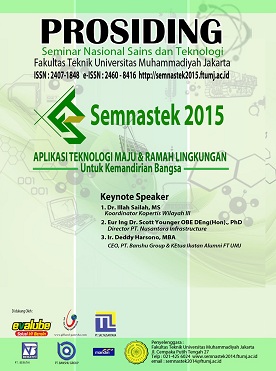SINTESA ASAM LAKTAT BERBAHAN BAKU TANDAN KOSONG KELAPA SAWIT MENGGUNAKAN TRICHODERMA RESEEI DAN LACTOBACILLUS ACIDIPILLUS
Abstract
Tandan kosong kelapa sawit (TKKS) merupakan limbah pertanian dengan kadar selulosa yang tinggi, sehingga berpotensi untuk dikonversi menjadi berbagai macam produk. Salah satu senyawa kimia yang dapat dihasilkan dari selulosa TKKS adalah asam laktat. Asam laktat merupakan bahan baku utama dalam pembuatan polimer biodegradable berupa polilactic acid (PLA). Penelitian ini bertujuan untuk mendapatkan konsentrasi mikroorganisme Lactobacillus acidophilus yang dapat menghasilkan asam laktat dengan konsentrasi yang tinggi. Tahapan penelitian meliputi pretreatment, hidrolisis dan fermentasi. Pretreatment TKKS menggunakan NaOH, Tahap hidrolisis selama 48 jam menggunakan Trichoderma reesei 5 % (w/w) dan tahap fermentasi selama 48 jam menggunakan Lactobacillus acidophilus dengan variasi 0.5; 1; 3; 5%. Analisa glukosa menggunakan spektrofotometri dan asam laktat menggunakan High performance liquid chromatography (HPLC). Konsentrasi gula reduksi yang dihasilkan dari proses hidrolisis sebesar 16,6-17,9 g/L dan konsentrasi asam laktat tertinggi 0.568 g/L didapatkan dengan penambahan Lactobacillus acidophilus 3%References
Carrasco, F., et al. 2010. Processing of poly (lactic acid): characterization of chemical structure, thermal stability and mechanical properties. Polymer Degradation and Stability, 95(2): p. 116-125.
Idris, A. and W. Suzana. 2006. Effect of sodium alginate concentration, bead diameter, initial pH and temperature on lactic acid production from pineapple waste using immobilized Lactobacillus delbrueckii. Process Biochemistry, 41(5): p. 1117-1123.
John, R.P., K.M. Nampoothiri, and A. Pandey.2007. Fermentative production of lactic acid from biomass: an overview on process developments and future perspectives. Applied Microbiology and Biotechnology, 74(3): p. 524-534.
K. Hofvendahl, B. Hahn-Hagerdal. 2008. Factors affecting the fermentative lactic acid production from renewable resources, Enzyme Microb. Technol. 26: 87-107.
L.Broto, S.Kardono. 2010. Teknologi Pembuatan Etanol Berbasis Lignoselulosa Tumbuhan Tropis untuk Produksi Biogasoline. Laporan akhir Program Insentif Penelitian & Perekayasa LIPI.
Lasprilla, Astrid JR, Martinez, Guillermo AR, Lunelli, Betânia H, & Jardini, André L. 2012. Poly-lactic acid synthesis for application in biomedical devices—A review. Biotechnology advances, 30(1), 321-328
Lopes, M Savioli, & Jardini, AL. 2012. Poly (lactic acid) production for tissue engineering applications. Procedia Engineering, 42, 1530-1542.
G.L. Miller. 1959. Use of dinitrosalicylic acid reagent for determination of reducing sugar, Anal. Chem. 31; 426-428.
Mukund,G.A, Anjani J.V, Gokhale. (2007). Lactic acid production from waste sugarcane baggase derived cellulose. Green Chemistry, 9, 58-62.
Pudjiastuti, W. and G. Supeni. 2005. Plastik Layak Santap (Edible Plastic) dari Tapioka Termodifikasi. Balai Besar Kimia dan Kemasan, Jakarta.
Rahmayetty, dkk(2013), Pembuatan Asam Laktat Berbahan Baku Tandan Kosong Kelapa Sawit Menggunakan Metode Sakarifikasi Fermentasi Simultan.Prosiding Seminar nasional Integrasi Proses 2014.
Sudiyani, Y., et al. 2013. Utilization of Biomass Waste Empty Fruit Bunch Fiber of Palm Oil for Bioethanol Production Using Pilot–Scale Unit. Energy Procedia, 32: p. 31-38.
Tomás, M.S.J., et al. 2003. Growth and lactic acid production by vaginal Lactobacillus acidophilus CRL 1259, and inhibition of uropathogenic Escherichia coli. Journal of Medical Microbiology, 52(12): p. 1117-1124.
Matsumoto, K.i. and S. Taguchi. 2010. Enzymatic and whole-cell synthesis of lactate- containing polyesters: toward the complete biological production of polylactate. Applied microbiology and biotechnology, 85(4): p. 921-932.
Mussatto, S.I., et al. 2008. Effects of medium supplementation and pH control on lactic acid production from brewer's spent grain. Biochemical Engineering Journal, 40(3): p. 437-444.

